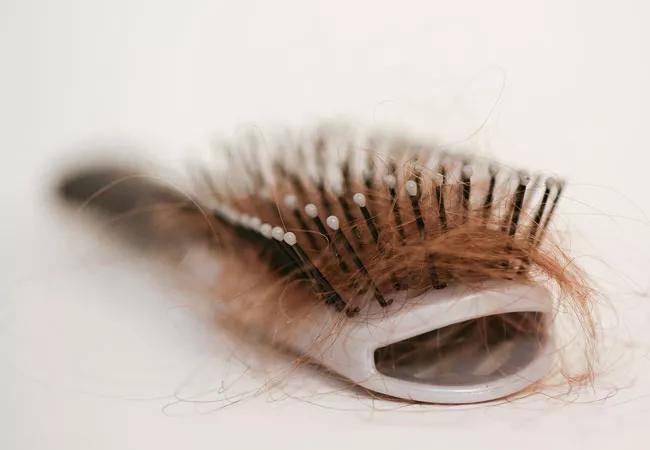Telogen effluvium as a consequence of COVID-19 infection

Although the list of COVID-19 symptoms from the U.S. CDC does not include hair loss, we are seeing an increasing number of reports, says Shilpi Khetarpal, MD, a dermatologist at Cleveland Clinic.
Cleveland Clinic is a non-profit academic medical center. Advertising on our site helps support our mission. We do not endorse non-Cleveland Clinic products or services. Policy
“We are seeing patients who had COVID-19 two to three months ago and are now experiencing hair loss. I think the timing is really crucial,” says Dr. Khetarpal.
The phenomenon is telogen effluvium, a nonscarring hair loss that is the result of an abnormal shift in follicular cycling.
“We see this a fair amount in dermatology,” Dr. Khetarpal explains. “Essentially, it is a temporary hair loss from excessive shedding due to a shock to the system. There are several common triggers, such as surgery, major physical or psychological trauma, any kind of infection or high fever, extreme weight loss or a change in diet. Hormonal changes, such as post-partum or menopause, can also be a cause. There are other medical or nutritional conditions that can trigger this as well.”
There are three phases in the hair follicle growth cycle: anagen (growth), catagen (resting) and telogen (shedding). Generally speaking, about 90% of hairs are in anagen, with 5% in catagen and 5% in shedding in telogen, says Dr. Khetarpal. Most people shed between 50 and 100 hairs each day.
In telogen effluvium, the proportion of hair follicles in the telogen phase increases significantly, up to 50%, leading to mass shedding. There’s generally a two- to three-month lag between the stressful event and the onset of hair loss.
“This is why we’re seeing these patients now, several weeks after COVID-19 symptoms resolve. Telogen effluvium isn’t a symptom of COVID-19 as much as it is a consequence of the infection.”
This hair loss can last for up to six to nine months. Generally, most cases resolve on their own, unless it’s related to medication or a nutritional deficiency.
According to Dr. Khetarpal, there are several risk factors associated with COVID-19 related hair loss. The first is genetic predisposition.
“We know some people can be extremely sick and not experience hair loss after, and others can have mild illness and have significant hair loss, so there is some genetic predisposition,” she says.
Nutrition also plays a role, especially iron, biotin and vitamin D.
“We know there are certain nutrients the body requires to build hair. If you have high iron stores, your body is going be able to support the hair more than, say, if you’re anemic and have other issues going on. The body doesn’t see the hair as essential, so if you have low iron stores, it’s going to shift that to make your red blood cells. It’s not going to focus on making hair. It’s just going to say, ‘Well, let the hair shed. We don’t need that.’”
“With telogen effluvium, the scalp should look completely normal. There should be no rash or other symptoms like itching, burning, pain or flaking. If these symptoms are present or there are visible changes on the scalp, patients should be referred to dermatology,” Dr. Kheterpal continues.
“I think it’s really important to reassure and counsel the patient that this will get better. Many patients fear going bald, especially women. This hair loss will improve, but it does take time to get back to normal.”
Patients should continue their normal hair habits, such as washing and styling.
Ensuring the patient consumes a well-balanced diet with fruits, vegetables and protein is very reasonable, says Dr. Khetarpal. “We may check iron and vitamin D levels, and perhaps recommend a multivitamin that contains iron or an iron supplement. A biotin supplement may help as well. In terms of medications, the best over-the-counter treatment for telogen effluvium is minoxidil 5%, which is FDA-approved for both men and women, but should be avoided if a woman is pregnant or breastfeeding.”
Dr. Khetarpal reports seeing more patients who are experiencing telogen effluvium since the beginning of the pandemic, including patients who have not tested positive for COVID-19. This form of stress-related hair loss can be the result of external stressors in addition to illness.
“There are so many pandemic-related stresses. There’s financial stress, concern for ill family members, anxiety about contracting the virus, social isolation and changes related to working and schooling from home. We are absolutely seeing hair loss in non-COVID patients that seems related to pandemic stress.”

Patients report improved sense of smell and taste

Clinicians who are accustomed to uncertainty can do well by patients

Unique skin changes can occur after infection or vaccine

Cleveland Clinic analysis suggests that obtaining care for the virus might reveal a previously undiagnosed condition

As the pandemic evolves, rheumatologists must continue to be mindful of most vulnerable patients

Early results suggest positive outcomes from COVID-19 PrEP treatment

Could the virus have caused the condition or triggered previously undiagnosed disease?

Five categories of cutaneous abnormalities are associated with COVID-19